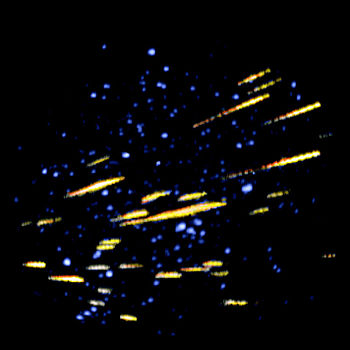If you are a serious astronomy fanatic like a lot of us are, you can probably remember that one event in childhood that started you along this exciting hobby. It might have been that first time you looked through a telescope. But for many of us, it was that first time we saw a rain of fire from the sky that we eventually came to know as a meteoroid shower .
.
 |
Photo of a part of the sky during a meteor shower over an extended exposure time.
The meteors have actually occurred several seconds to several minutes apart. (Photo credit: Wikipedia)
|
At the time when you see the first one, it’s easy to remember the movie “war of the worlds” or some other fantastic image of aliens entering our atmosphere in droves to take over the planet. But with some guidance and explanation of what was going on, we eventually learned that these showers were not at all threatening or any kind of invasion. For the most part meteoroid showers are harmless, part of nature and very fun to watch.
So what are these strange lights in the sky? Are they aliens invading from Mars? Are the comets coming to start the next ice age? Or perhaps asteroids burning up as they enter the earth's atmosphere. The answer to the above questions is no to the first and “yes and no” to the other two.
A meteoroid is actually a small piece of space rubble, usually dust or small rocks that come from either a comet or the break up of an asteroid in space and that eventually plummets toward the earth. We say “toward the earth” because the lights you see are the friction of the atmosphere burning up those small space tidbits and creating a spectacular show for all of us as they do so. A particularly exciting moment to witness is when a meteoroid breaks up or explodes on entry. A meteoroid that explodes is called bolides.
There are some interesting details about the life of a meteoroid that make the viewing of shooting stars even more fun. To be seen, a meteoroid only needs to weigh as little as a millionth of a gram. But the thing that makes them so spectacular to see is the tremendous speeds they reach as they enter the atmosphere. Before burning up, a meteoroid will reach between 11 and 74 kilometers per second which is 100 times faster than a speeding bullet.
that make the viewing of shooting stars even more fun. To be seen, a meteoroid only needs to weigh as little as a millionth of a gram. But the thing that makes them so spectacular to see is the tremendous speeds they reach as they enter the atmosphere. Before burning up, a meteoroid will reach between 11 and 74 kilometers per second which is 100 times faster than a speeding bullet.
We tend to think of t seeing a shooting star as a freak event and we associate it with superstition (hence, wish on a lucky star). But there are actually thousands of them every year so it really isn’t that rare to see one. In fact, scientists tell us that over 200,000 tons of space matter enters the atmosphere each year and burns up on entry.
Comets are a big source of meteoroids because of the nature of those long tails. A large amount of dust, ice, and other space debris gets caught up in a comet’s tail as it moves toward the sun. Then as the comet moves away from the sun in its orbit, tons of this matter is thrown off into space to disperse. As the Earth moves in its routine orbit around the sun, it often crosses through clouds of this discarded matter which becomes one of those “meteor showers” that are so popular for viewing.
These showers of shooting stars are pretty easy for astronomers to predict so you can get into position to see the excitement at just the right time of night and be looking at the right area of the night sky. Usually, the astronomy magazine or site will give you a general time and location to be ready to look when the meteoroids start to fall.
Now keep in mind, this is a phenomenon of nature so it may not observe the time table exactly. Also, note that there is a notation system for where the meteoroid shower will occur based on what constellation is its backdrop. The section of the sky to focus on for the show is called the “radiant” because that is where the entering meteoroids begin to glow or radiate. The radiant is named after the constellation it is nearest to. So if the meteor shower is going to occur in the constellation of Leo, then its radiant will be called Leonid. This will help you decipher the listing of asteroid showers in the publications.